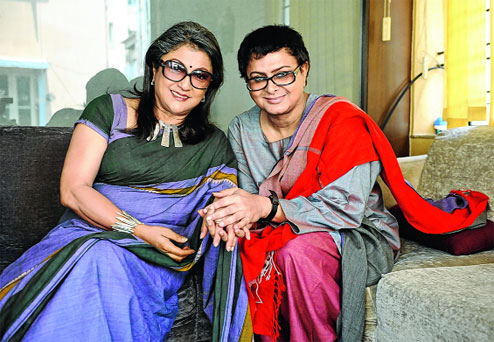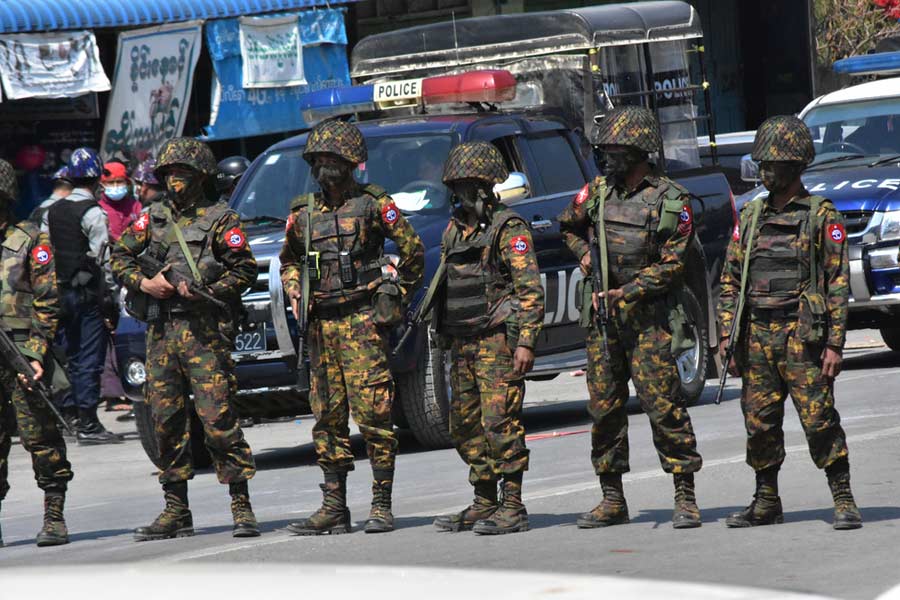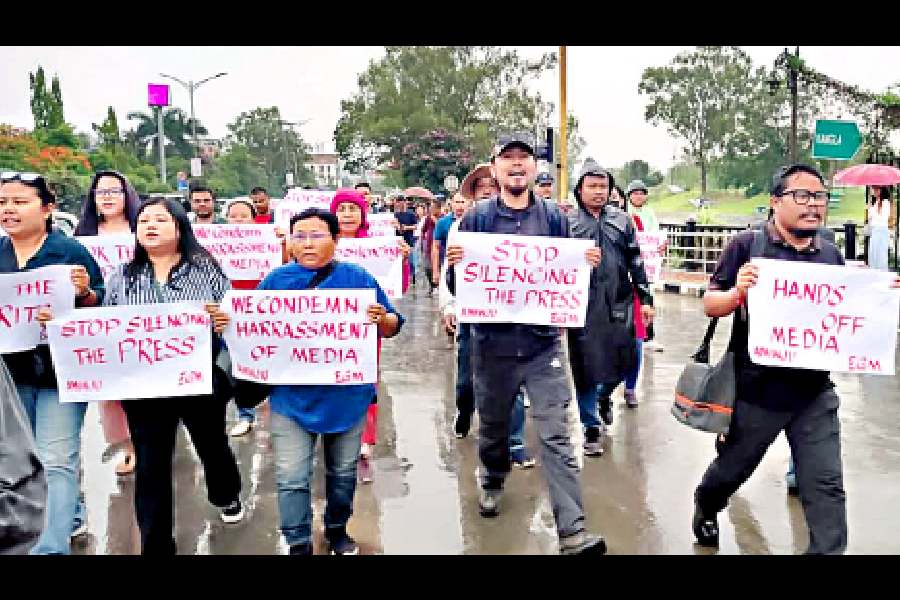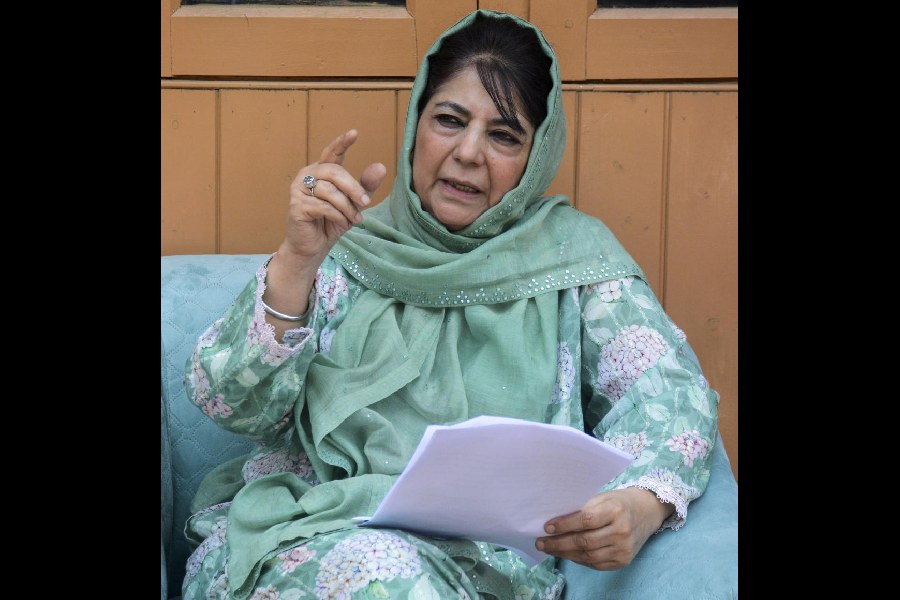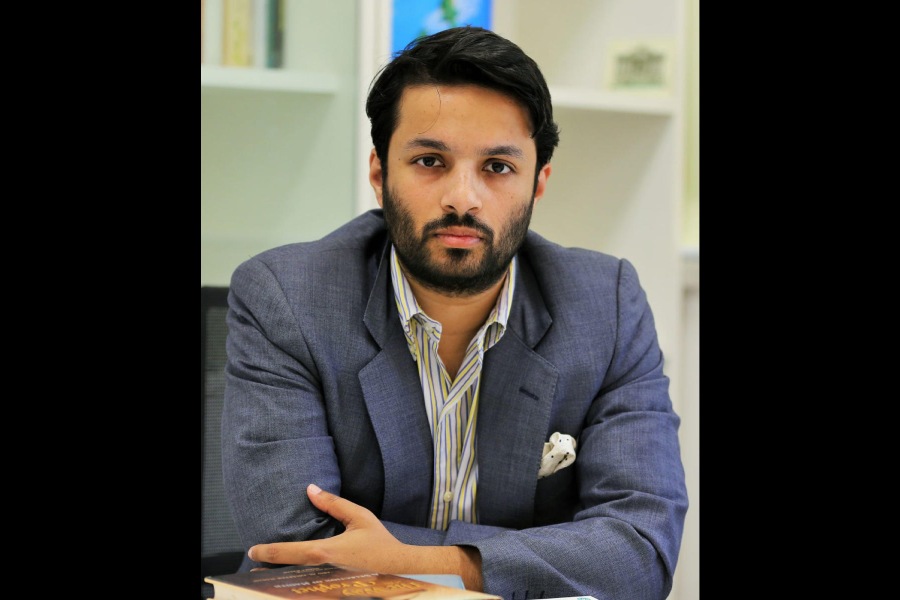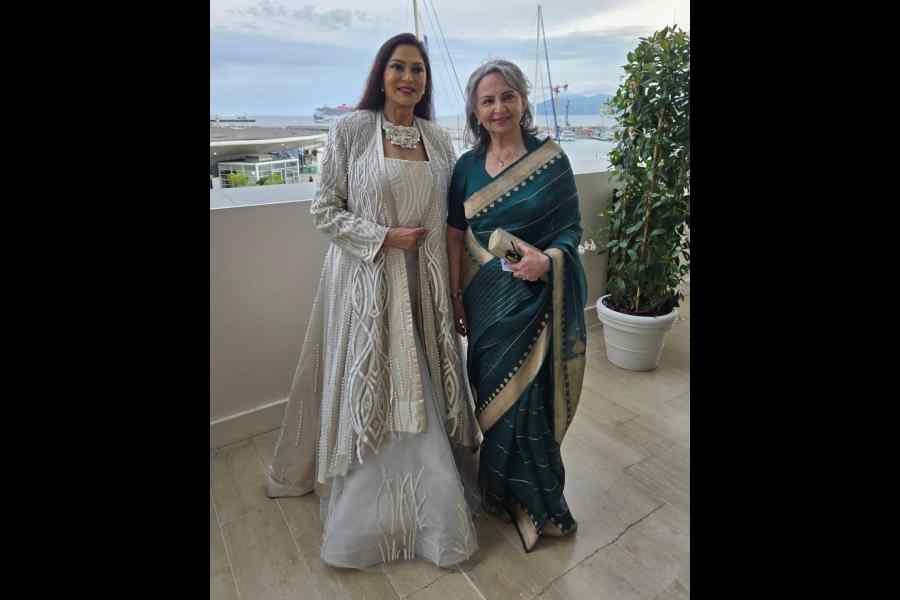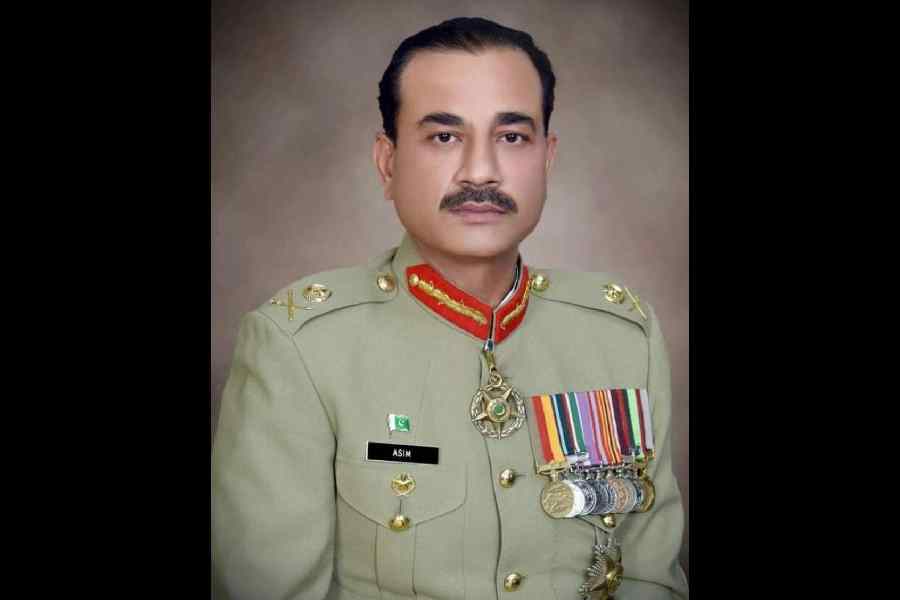 |
We can talk about Goynar Baksho the whole day!” laughed Rituparno Ghosh, who hasn’t seen the film yet but about a decade ago had heard Aparna Sen’s script several times over. It was but natural that Wednesday morning would be like a deja vu for both when the two filmmakers met to talk about Goynar Baksho for t2 — moving back and forth in time, picking out memories and discovering new facets about themselves. What followed was an engaging one-hour-30-minute journey into the mindspace of Bengal’s two most celebrated filmmakers — also a space where she’s “Rinadi” for him and he’s “Rinku” for her.
Rituparno: So Paromitar Ekdin, Iti Mrinalini and now Goynar Baksho, your next Bengali film...
Aparna: You know what, with the kind of films we make today, I feel our films don’t need a specific language anymore. It’s of course different if it’s a film like Goynar Baksho that is of a certain period, which needs a certain language and place. But say, Goutam’s (Ghose) Shunyo Awnko…. The Maoists surely won’t speak in English amongst themselves, whereas Konkona (Sensharma) and the doctor (Dhritiman Chaterji) will possibly speak in English.
R: Yes, I feel it’s time to celebrate our multi-ethnicity in our cinema. And we should not think in terms of Bengali cinema, Hindi cinema or English cinema.
A: Yes. Films should have subtitles…
R: But on the basis of dialogues too, I seriously feel ‘multilingual’ should be a separate category in films. Because when we send our films for censorship, they see how many films are in Bengali and how many are in English.
A: Which is exactly the problem I faced with Japanese Wife! Because I had said that Japanese Wife was a Bangla film (smiles). Only the letters (they write to each other) are in English. And the English is also like Bangla (laughs).
R: It is Bangla... here’s a Bengali boy in a Bengali milieu trying to speak in English.
A: So Rinku, what you are saying is that Goynar Baksho is my next Bengali film after Paromitar Ekdin...
R: No, after Iti Mrinalini…
A: Iti Mrinalini, yes…
R: Your Bangla films are Parama, Yugant, Sati, Paromitar Ekdin, Iti Mrinalini and now Goynar Baksho. And your English films are 36 Chowringhee Lane, Mr. & Mrs. Iyer, 15 Park Avenue… and The Japanese Wife, if it can be called an English film… there’s a bit of ambiguity there.
A: Let it be.
R: Now, many of your films start with the city. 36 Chowringhee Lane did...
A: Hmm…. Calcutta.
R: The second one (Parama) too was about Calcutta.
A: Yes…
R: The third (Sati) went to the 19th century. You did a lot of research for it and then you did Yugant which, though is set on the seaside, I feel is a very urban film.
A: See, the fishermen aspect in Yugant is entirely a metaphor. (Pauses) For instance, when there’s a war, people who are not involved with it at all suffer and die. Yugant is a metaphor for that.
Marriage in her movies
R: Simultaneously, Yugant questions urban domesticity and the institution of marriage… which you had also questioned in Parama.
A: Yes, but Yugant had a lot of metaphors. I mean the disintegration of the marriage (Roopa Ganguly-Anjan Dutt) becomes a metaphor for the disintegration of everything around us, everything on this planet...
R: So you questioned the institution of marriage in Yugant and Parama in different ways… and also in Paromitar Ekdin! The relationship between Paromita (Rituparna Sengupta) and Sanaka (Aparna), her mother-in-law, is more than just an extension of the marital relationship. There’s a friendship between them.
A: Actually Paromitar Ekdin begins where Parama ended. See, in Parama... when a woman got married in our society, she married the whole family. And all her relationships were defined by the primary relationship with her husband. But in Paromitar Ekdin we find that it is no longer defined that way. Here the girl and her mother-in-law both have a strong mind of their own. An independent relationship is formed, which couldn’t happen in Parama.... Look at the time gap between the two films…
R: Fifteen years...
A: Akta difference hobe na?
R: Long enough for our understanding to change, for our perspective to change...
A: And society changes too, that is also being reflected.
R: But Mr. & Mrs. Iyer is almost a spoof of a marriage!
A: I will say something? I wouldn’t like to call it a spoof of a marriage…
R: We can call it a critique maybe…
A: Tao noy re sona.... You know, I genuinely feel that a man and a woman may be married but it is how society views them which determines whether they are ‘married’ or not. In Mr. & Mrs. Iyer, the fact that they (Rahul Bose and Konkona Sensharma) ‘appear’ as a couple in front of others defines their ‘marriage’, even if they are not really married. So it’s society that’s viewing them as man and woman, which makes them husband and wife.
R: And since society has created it, they have to live it.
A: Yes, they do that! And what about Meenakshi’s (Konkona) strange dependence on Raja (Rahul), and his sense of duty towards her? It happens because they start living together and now they can’t return to the point when they were just strangers. So I would say there’s an exploration of the nature of marriage in Mr. & Mrs. Iyer.
R: After three films on marriage... The Japanese Wife of course is a strange story, they get married without even seeing each other!
A: (Amar) Kawtogulo chhobite biye!
R: Hyan tui bhebe dyakh, tor kawtogulo chhobite biye! Biyeta kawto important! And both Mr. & Mrs. Iyer and Japanese Wife look at the conventional notion of marriage through completely different prisms.
A: Yes! In Japanese Wife, there’s a pledging of love, pledging of loyalty, which a true marriage actually is. (Pauses) While it might not be there in a real marriage! (Laughs)
There’s another very interesting thing in Japanese Wife. Here are two marriages, because Snehamoy’s (Rahul Bose) relationship with Sandhya (Raima Sen) is also like a marriage. That’s why there are two widows at the end. And Sandhya can’t even mourn Snehamoy’s death. She does not have a legitimate reason, he is porpurush for her…. Goynar Baksho also deals with marriage and widowhood.
R: Marriage, widowhood and the fact that a woman loses all her right to live, to desire, with the death of her husband…
A: Which is constantly there in Chokher Bali too. Binodini and Pishima (in Goynar Baksho) are so similar!
Magic realism
R: When we make a period film, we are trying to construct a certain time or history. How do you think we can relate it to our modern sensibilities?
A: Dyakh, I feel the basic emotions always remain the same, these never change. One of our relatives was married into a royal family and she had a relationship with her brother-in-law. After her husband’s death, when the brother-in-law would come into her room, no one would walk in by tacit agreement. So these things have always been there... human desires and relationships. I remember another incident which is very relevant to Goynar Baksho. Priti mashi, one of my mother’s friends, had an aunt who was a child widow. When she was 70-75, one day she told a roomful of women: ‘Ei je sarajibon aami sati hoye roilum, ete amar ki labh?’ And that was so long ago! So, the way of expressing it changes, but the emotions remain the same. The basic responses change according to the society that is viewing it.
R: Which genre would you say Goynar Baksho belongs to?
A: Aha, that’s a very good question! (Laughs) I don’t think Goynar Baksho belongs to any particular genre. It starts by being a comedy, and it is quite an uproarious comedy, but it ends in a completely different way. I would wonder if Shirshendu Mukhopadhyay (the writer of Goynar Baksho) had read a lot of Latin American literature… magic realism. There are so many things in it! There’s storytelling, bizarre things happen, then there’s passion, love, the fervour of patriotism, and all of it blends so seamlessly. If you read Isabel Allende’s The House of the Spirits, there’s so much happening there that you won’t feel it is a particular genre. I am a great fan of Latin American literature.
Not about ghosts!
R: After Bhooter Bhobishyot, people might think Goynar Baksho is another ghost film. Is that desirable for you as a director? Because I know that you had written the script in 1992 and we have been hearing it since (both laugh) with different casting. I, for one, know that it is not about ghosts!
A: See, even if people come to watch it as a ghost film, it’s up to me as a director in which way I would steer their emotions. (Smiles)
R: Now, on another level, if I see Goynar Baksho as magic realism, will it be wrong to say that this journey started with Yugant, with the seeing-the-tortoise scene?
A: Absolutely! That’s very perceptive of you! In fact, the whole scene about Roopa falling into the water…. Jaanish Rinku, I am getting very bored with all this everyday reality, modhyobitto prem, middle-class anxieties.... So you will see me slipping into other things whenever I get a chance. The ending of 15 Park Avenue, for instance. All this while Konkona was in their reality, and now Shabana (Azmi) and the rest get into her reality. I feel our audiences are still not exposed to how magic realism can be used as a device for transcendence.
R: Alongside, we have Buddhada (Dasgupta) doing so much work on magic realism...
A: Koto kaaj korechhe and I have loved it!
R: And he’s never bothered about whether people saw them or not…
A: His main audience is abroad.
R: I feel people have started accepting it (magic realism) now...
A: Yes. Now if the whole film is in magic realism, I don’t know how much people will appreciate it. But if there’s just an element of it, then...
R: Like I did with Anjan’s (Dutt) character in Chitrangada…
A: Yes and I liked it so much!
Chime for change
R: So Goynar Baksho is a story of three generations of women — Rashmoni, her bhaipo-bou (niece-in-law) Somlata, and Somlata’s daughter Chaitali, right? You may have changed the script since I had read it, but I feel it will be a very entertaining film for everyone…
A: It has a wide expanse. And whatever is told has been told very lucidly. Yet there is a lot of social message in it. It’s not at all preachy… you will know when you see it, we have used music very interestingly. When we are looking at a young Pishima, I have used Rabindranath, Chandidas and Vidyapati together!
R: Really!
A: (Smiles) Yes… but if I talk about it it would give away the surprise...
R: No, no, let it be a surprise! I want to see it.
A: So from the fun and laughter, the suffering of Pishima comes through and you feel the pain.
R: That is the mark of a good film. This constant striving to create a complementary narrative…. Are you happy having done this film? Tor toh shob somoy chhobi shesh howar poreo akta khunt-khuntani thaake...
A: I wish we had more time for post-production. For instance, there’s the Mukti Juddho...
R: Oh yes, tell me about that! The Mukti Juddho is not there in Shirshenduda’s story….
A: Sheta toh tor songe alochona korte kortei berolo, mone achhe! A very important element in Goynar Baksho is the journey of the jewellery box. The jewellery, for Pishima, is hoarded or blocked capital. For Somlata, it becomes capital. When it comes to Chaitali, times have changed even more. She’s a modern girl of the Seventies with Leftist ideals... tokhon jamon hoto, like we all were.... So Mukti Juddho and Naxal Andolan were the two things happening at that time. I didn’t bring in the Naxal Andolan because it would have been too heavy then.... So everybody is involved in the Mukti Juddho and even Pishima gets involved! (Laughs) Because Pishima actually starts living only after she becomes a ghost… through Somlata and then Chaitali. She chats with Chaitali about all kinds of things… thakuma and naatni even smoke together. Now these two decide to use the jewellery for Mukti Juddho.
R: So, there’s something very interesting happening here. The Mukti Juddho, which is about the struggle for freedom of language, is actually giving these women a chance to be a catalyst for change! Alongside the people fighting for their mother tongue in Bangladesh, the women (in Goynar Baksho) are also trying to find a language of their own…
A: Exactly. They are looking for an identity of their own. The Mukti Juddho reflects the changing position of women in society and also the changing relationship between women and their jewellery.
Women have always loved to deck up in jewellery. Tribal women wear so much beaded and wooden jewellery. If you look at my goynar baksho, it is full of all that! Wood, silver, metal, beads... I love wearing these! But when women have valuable jewellery — not like mine! — then that becomes a kind of security. That’s why it’s called streedhan. Pishima says her jewellery is her streedhan. That’s the reason, she says, she could stay on in her brothers’ place after becoming a widow. See, Parama dealt with the economic position of women in society, it’s there in Goynar Baksho too...
R: The need for women to earn.
A: And I deeply believe in it.
R: But now we also need to be aware that for women, their asset is not just jewellery, it is their intelligence, their talent to earn. That is their streedhan.
A: Yes, and Somlata marks its beginning.Another interesting thing is that the Hindu-Muslim aspect has always come very spontaneously in my films, it’s never in-your-face. There’s Raja in Mr. & Mrs. Iyer, Imtiaz in Iti Mrinalini, Rafiq in Goynar Baksho. But alongside the inter-communal, there’s also the inter-caste in Goynar Baksho. You see, Pishima couldn’t get Ramkhilaon (the darwaan)... they kill him. But Chaitali gets Ramkhilaon’s grandson Benu. What I have done is, I got the same actors to play both Pishima and Chaitali, and Ramkhilaon and Benu.
R: And the fact that you got so many layers is because there’s an element of absurdity in Shirshenduda’s story. That’s his contribution.
A: Exactly! That’s a huge contribution. And he gave me a brilliant character in Pishima.... I hope it does well, Rinku...
R: I know it will do very well!

